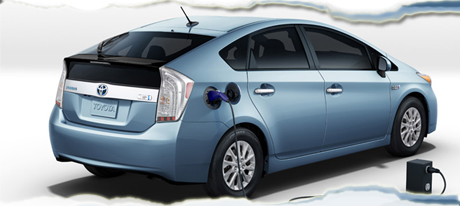
2012 Toyota Prius v Hybrid
All-New 2012 Model Morphs to Hatchback
By Bob Plunkett
It only takes the blink of an eye to observe that Toyota's new fourth-generation design for the 2012 Prius hybrid electric vehicle differs from the previous version -- it's larger in a streamlined package that fashions the hood and windshield into a racked-back plane which resembles a rakish two-door GT coupe while flanks reveal the four-door configuration of a practical sedan as the roofline hikes high toward the tail to accommodate a hatchback-style rear cargo door.
This new design earns an aerodynamic rating of merely 0.29 cD (coefficient of Drag), which makes the 2012 Prius one of the slickest set of wheels on the road.
It's still pegged in the mid-size class of sedans, but the wheelbase grows 3.1 inches longer and the overall tip-to-tail measurement increases by 6.1 inches to 181.7 inches.
The passenger compartment -- long and broad and tall, thanks to the mid-size front-wheel-drive platform with wheelbase drawn to 109.4 inches -- provides ample room for five passengers on comfortable seats with a pair of buckets in front of a bench for three and room at the rear for cargo due to the hatchback roofline.
Name badge of this version acquires the alphabet letter "v" tacked on -- Prius v -- with v denoting versatility with the hatchback design.
Then numerical figures follow the v on the nameplate to describe three trim grades: Prius v Two, Prius v Three and Prius v Five. (There's no explaining the absence of Prius v One and Prius v Four editions.)
All 2012 Prius v issues employ Toyota's proven Hybrid Synergy Drive (HSD) system.
The HSD system controls all energy produced by on-board gas/electric engines and applies it directly to the front wheels in infinitely variable measures through the electronically controlled continuously variable transmission (ECVT).
It teams a thrifty but conventional 1.8-liter four-cylinder Atkinson-cycle engine that sips gasoline with a pair of high-voltage and high-torque electric motors -- one to turn the front wheels and the other to work so many power accessories as well as crank up the four-pack engine and recharge a load of on-board batteries.
Prius in this new version can run on the gasoline engine or on the electric motor, or in a mode with both plants contributing power simultaneously.
Toyota provides four driving modes:
* D -- for Drive, the standard driving mode with all systems working together automatically.
* EV -- Prius moves solely on battery power at low speed for about a mile.
* POWER -- the throttle increases sensitivity for quick accelerations, yet fuel economy suffers.
* ECO -- the economy mode to trim fuel consumption by managing throttle response and restraining power drawn by the air conditioning system.
The four-cylinder gasoline-fired plant, with dual overhead cams and Toyota's smart variable valve-timing (VVT-i) system, musters 98 hp plus torque of 105 lb-ft.
The permanent-magnet synchronous motor by itself can produce 80 hp (60 kW) and 153 lb-ft of torque.
Combined output for the HSD runs to 134 hp, or 100 kW.
Supplying electrical juice to the HSD is a direct-current nickel metal hydride (Ni-MH) battery tucked beneath the cabin's back seat.
Because the 2012 Prius is a larger vehicle than previous editions, front and rear suspension systems were redesigned to improve handling and ride quality.
We get to steer a 2012 Prius v Five into the Rocky Mountains by running up wiggly Canyon Boulevard out of Boulder, jigging around jagged Comfort Mountain and the placid Barker Meadow Reservoir before reaching the high-altitude village of Nederland.
Even with altitude and hill grades, our Prius earns notable fuel economy scores. (Federal EPA fuel consumption scores for the 2012 Prius reach 44 mpg for running on city streets for SULEV and Tier2 Bin3 emissions standards.)
The acronyms in car safety for Prius include variable gear ratio steering (VGRS) and electric power steering (EPS), electronically controlled brakes (ECB), anti-lock brake system (ABS), vehicle stability control (VSC) and active traction control (TRAC).
Standard content for a 2012 Prius v Two lists 16-inch alloy wheels with full wheel covers and 205/60R16 tires, projector-beam halogen headlamps and LED tail lamps, power heated exterior mirrors, automatic climate controls, fabric-trimmed front seats with six-way adjustable driver's seat and four-way adjustable fold-flat front passenger seat, 60/40 split sliding/reclining/folding rear bench with center armrest and adjustable headrests, Smart Key with Push Button Start, digital instrumentation with speedometer/odometer, twin tripmeters, a fuel gauge and Hybrid System Indicator.
Prius v Three gains Display Audio with Navigation (6.1-inch touch screen with backup camera, AM/FM/CD/MP3/WMA, six speakers, HD Radio with iTunes, USB port with iPod).
Prius v Five gets 17-inch alloy wheels, LED headlamps and integrated foglamps, SofTex-trimmed heated front seats and an auto-dimming rearview mirror.
Toyota's MSRP chart for the 2012 Prius v begins around $22,000 for Prius v Two.
Toyota Prius v Pricing info and additional Toyota reviews
at Automotive.com.
For more info on the Toyota Pruis, click here.
Visit RTM's Road Test Review Archive
__________________________________________
Check out RTM's 2012 Green Car Buyer's Guide
By Martha Hindes |